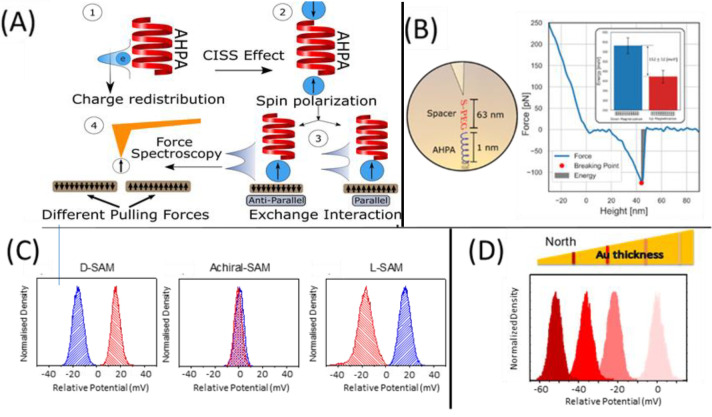Figure 3.
FM/chiral molecule interactions. (top) Direct measurement of the exchange interaction between the FM and the chiral molecules. (A) α-Helix polyalanine (AHPA) is adsorbed on a gold AFM cantilever. The system is immersed in ethanol to reduce capillary forces. The sample under study is an MBE grown Co-based nanostructure with an out-of-plane easy axis. When the tip is close to the sample, reorganization of the electric charges in the molecule (1) results in spin filtering due to the CISS effect (2), which is followed by an exchange interaction between the molecular wave function and the wave function of the substrate (3). This interaction is sensed by the deflection of the AFM cantilever (4). (B) (left) Schematic of the tip with the adsorbed molecules; (right) typical force dependence on the tip–surface distance; the pulling point of the molecule and the integrated area represent the pulling energy of the molecule. Inset shows the mean pulling energy for the up and down direction of perpendicular sample magnetization, showing a difference of 150 meV. The standard error of the mean is shown. Reprinted from ref (4) with permission. Copyright 2019 Wiley-VCH. (bottom) Contact potential difference for chiral and achiral self-assembled monolayers on magnetized surfaces. (C) Histograms, obtained from Kelvin probe measurements of the contact potential difference (CPD) for chiral and achiral self-assembled monolayers on Ni/Au magnetized surfaces, reveal an enantiospecific response for chiral molecules and no magnetization response for achiral molecules. (D) Change in the CPD as a function of the Au layer thickness for Co magnetized films with adsorbed L-A5 (SH-(CH2)2-NH-(Ala-Aib)5-COOH) SAMs. The top diagram represents the Au wedge, and the color of each plot corresponds to the region indicated on the gradient bar by the same shade. Reprinted with permission from ref (18). Copyrights 2020 American Chemical Society.

